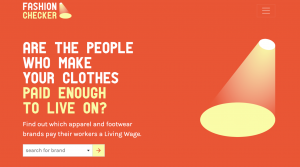
Wear Your Values – An Insight into Fast Fashion
By: Emily Kim, Second Year in Emory College, Chemistry and NBB major
I’m sure you’ve heard it before: “use code ____ for 15% off”. Even if you haven’t, we’ve all seen great bargains for the cheapest, trending clothing option on the internet, and to no one’s surprise, big corporate companies recognize this, too. They pop subtle ads in your social media and use influencers to encourage consumption of fast fashion – a term that I like to think of as the opposite of long-lasting, transparent, and innovative when it comes to clothing.
While large brands like H&M, Forever 21, Gap work on market research, design, sales, and marketing in high-income countries, production is outsourced to countries such as India, Ethiopia, China, Vietnam, Bangladesh, and even some parts in the US. Because these brands are not legally affiliated with manufacturers, they are not obligated to ensure safe and legal working conditions and wages. As a result, workers in these countries often suffer under dangerous working conditions and low wages but are forced to continue working there in order to support their families.
The problem of fast fashion harming workers in other developing nations feels like an issue that is very far away. In fact, the issue hits pretty close to home. Most of the clothes you’re wearing are likely to have originated from outside the US in factories without legal obligations to create a safe working environment. In LA, the Federal Labor Department realized their outfits are made by “sewers [who] earn as little as $2.77 an hour” (NYtimes, 2020).
Clothes have always been a symbol of wealth and status. As messed up as it is, the biggest fast fashion brands have the largest low-income consumer population. Fast fashion is easy, accessible, and affordable, whereas sustainable brands are often expensive and size-limited.
The fashion industry is, has always been, a toiling machine. According to Goodonyou.com, “new designs are made in less than 2 weeks, and 1000 new styles are released every week.” Mass-marketing retailers keep an eye out for looks on the runway, trends alluring the public, and influencers who can connect the masses to high-end, unaffordable looks. Not to mention, this happens every year, every season, and every month: “The average American now generates 82 pounds of textile waste each year. That adds up to more than 11 million tons of textile waste from the U.S. alone” (Darmo, 2020).
Have you ever wondered where unsold clothing goes? Instead of donating or upcycling clothing, most fast fashion companies toss or burn their unsold stock, leading to dire losses of natural and financial resources (Lieber, 2018). Two years ago, Burberry “destroyed $36.8 million worth of its own merchandise” that led to a country-wide Burberry Boycott and #burberryburn trending on social media (Lieber, 2018). In 2017, H&M reported to have “burned 60 tons of new and unsold clothes since 2013” (Lieber, 2018). A short documentary set in Panipat, India highlights women shredding brand new clothing shipped from the US.
“The fashion industry produces 20% of global wastewater and 10% of the entire world’s carbon emissions” and “more than 500 billion dollars of value is lost every year due to clothing underutilization and the lack of recycling” (UN, 2020). To give you a rundown, “Washing, solvents, and dyes used in manufacturing are responsible for one-fifth of industrial water pollution” (McKinsey, 2020). According to TuftsDaily, “the average woman in America [owns] seven pairs of jeans and the average American family [washes] around 8-10 loads of laundry per week” (Smith, 2020). With each load of laundry, it collectively adds up to “half a million ton of microfibers…released into the ocean when clothes are washed per year” (Smith, 2020). Fashion accounts for 20 to 35 percent of microplastic in our ocean (The State of Fashion, McKinsey 2020).
Although our lives may seem distant from these hard facts, our ecosystem is connected and what we choose to decide for the short-term will impact all of us in the long-term. Whether we like it or not, we’ve already impacted the planet. There’s no such thing as a “re-do” on the results we’ve already made. However, each year 20% can become 10% and 10% can become 0% and we can change.
Here’s how:
- View clothing as long-lasting and versatile.
Invest in basics that you’ll continually reach for in the years to come. Stop yourself from looking at Instagram trends with an “I need that” mentality, but observe your wardrobe to see what you’re missing.
Although currently it’s hard to bridge the financial gap between sustainable brands and affordability, one solution is to go thrifting. Thrifted clothing allows a green cycle of buying and selling clothes. I would also recommend checking out Pact and Thredup, both online brands that sell a wide range of prices. However, always remember that the best solution is to evaluate your wardrobe and continue to consider “do I really need that?”.
- Use Fashion Checker 2020 to see which of your favorite brands are producing fast fashion.

- Understand the Fashion Transparency Index 2020
Transparency is huge! We want to be able to support brands that are paying their workers fair wages with safe and healthy working conditions, and that do not violate human rights within supply chains.
- Get involved and stay informed!
Use your voice on social media, reach out to local activists, and help support your favorite sustainable movements, whether it be through donations or volunteering. Here’s one way to start: https://www.patagonia.com/actionworks/#!/explore/home. As long as you feel a strong urge to change the current fashion industry, there is always an opportunity to get involved.
For more insight: 20 facts about fast fashion, What United Nations is Spearheading, and Global impacts on Fast Fashion.
- Give your friends a slight nudge on what you’ve learned and help pay it forward.
This is so important! The meaning behind “sustainability” has become distorted into a term that many brands label onto their clothing-line when in reality the companies do this to lure you into thinking that one word means the brand is safe from fast fashion. However, this is the company making decisions for you. Now that you have all these resources, you can make the decisions for yourself, your friends, and especially for those who didn’t know.
- Follow, like, and forward local organizations and/or clubs on campus that promote clean clothing.

I’m one of the co-founders of altKEY, a new sustainable fashion-forward movement (2020), and we’re reaching out to students at Emory about sustainability and fast fashion. One of our biggest projects for 2021 is our virtual fashion show, the KEY, on April 10th, looking to promote student designers, panel speakers, and local Atlanta grass-root businesses. Follow us on Instagram, on facebook, on linkedIn, and visit our website!
Due to COVID-19, there is mounting pressure on the fashion industry to return to the normalcy of mass production and the pursuit of high profits. However, the crisis must not be a limitation to what can be done for a greater change. The fashion industry is an entity that is always changing, fashion today can be outdated by the time we reach 2021. Yet, we can decide what we consume, and we can collectively demand the change we’d like to see in the fashion industry. Let’s do this together.
Works Cited:
Chavie Lieber. “Burberry, H&M, and Nike Destroy Unsold Merch. An Expert Explains Why.” Vox, Vox, 17 Sept. 2018, www.vox.com/the-goods/2018/9/17/17852294/fashion-brands-burning-merchandise-burberry-nike-h-and-m.
Crumbie, Alex. “What Is Fast Fashion and Why Is It a Problem? | Ethical Consumer.” Ethical Consumer, 5 Sept. 2019, www.ethicalconsumer.org/fashion-clothing/what-fast-fashion-why-it-problem.
“Home – The UN Alliance for Sustainable Fashion.” The UN Alliance for Sustainable Fashion, 2019, unfashionalliance.org/.
Darmo, Jennifer. “20 Hard Facts About Fast Fashion.” Good On You, 27 July 2020, goodonyou.eco/fast-fashion-facts/?utm_source=GoodOnYou-email.
Kitroeff, Natalie. “Fashion Nova’s Secret: Underpaid Workers in Los Angeles Factories.” The New York Times, 16 Dec. 2019, www.nytimes.com/2019/12/16/business/fashion-nova-underpaid-workers.html.
Smith, Colette. “In Face of Environmental Repercussions, Sustainable Fashion Takes Hold.” The Tufts Daily, 5 Nov. 2019, tuftsdaily.com/arts/2019/11/05/face-environmental-repercussions-sustainable-fashion-takes-hold/. Accessed 3 Dec. 2020.
“The State of Fashion 2021: In Search of Promise in Perilous Times | McKinsey.” Www.Mckinsey.com, 2020, www.mckinsey.com/industries/retail/our-insights/state-of-fashion#. Accessed 3 Dec. 2020.
“Waste and Pollution.” Clean Clothes Campaign, 2020, cleanclothes.org/fashions-problems/waste-and-pollution.

I want to express my gratitude to this writer who writes very well and covers all the information on the topic. I have never read this information before. This is really an amazing topic which means a lot.
Such incredible advice from so many awesome sources! I love it!
Fashion is passion. Thank you very much for sharing your thoughts. It is amzing.
This is a very impressive blog and this is an informative article based on very unfortunate true facts. Thanks to the author for sharing the post with us. Consumers, as well as retailers, have to change their sight regarding the fast fashion workers and recycling their products to save water and stop carbon emissions.
Fashion is passion. Thank you very much for sharing your thoughts. It is amzing.